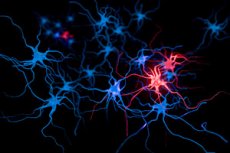New publications
Narrow Venules, Big Impact: A New Vascular Mechanism of Brain Aging
Last reviewed: 18.08.2025

All iLive content is medically reviewed or fact checked to ensure as much factual accuracy as possible.
We have strict sourcing guidelines and only link to reputable media sites, academic research institutions and, whenever possible, medically peer reviewed studies. Note that the numbers in parentheses ([1], [2], etc.) are clickable links to these studies.
If you feel that any of our content is inaccurate, out-of-date, or otherwise questionable, please select it and press Ctrl + Enter.

Scientists have shown in mice that with age, blood flow through a rare network of "principal cortical venules" (PCV), which drain the deep layers of the cortex and adjacent white matter, is disrupted. The result is mild hypoperfusion in deep tissues (layer VI and corpus callosum), accompanied by microgliosis, astrogliosis and demyelination. And artificially reducing blood flow in adult animals reproduces the same pathology, which indicates that the issue is not only in neural "wear and tear", but also in capillary-venous drainage as a causal factor. The work was published in Nature Neuroscience on August 12, 2025.
Background
- Hypoperfusion as a leading factor. Modern reviews agree: chronic underperfusion of deep tissues is a key axis of SVD/WMH pathogenesis (together with inflammation, oxidative stress and BBB disruption). Intensive blood pressure control slows down the progression of WMH, which indirectly confirms the vascular nature of the problem.
- "Venous" hypothesis of white matter aging. Also, periventricular venous collagenosis and association with leukoaraiosis have been described based on pathomorphology data; enhanced deep medullary veins are visible on MRI in some patients. This gave rise to the idea that vulnerability of white matter may be associated not only with arterioles, but also with venous outflow disorders.
- Anatomical vulnerability of the brain's wiring. Short association fibers (U-fibers) and superficial white matter make up a significant proportion of the pathways and show age-related changes in structure and connectivity - hence any long-term perfusion failure is particularly sensitive here.
- What was missing before the current work. There was almost no direct in vivo evidence that it is precisely bottlenecks in capillary-venous drainage (and not just arterial factors) that trigger gliosis and demyelination in white matter during aging. The new study closes this gap: the authors showed in mice that selective “sagging” of capillary-venous networks in the deep layers of the cortex and adjacent white matter leads to chronic hypoperfusion → gliosis → myelin loss; a similar picture occurs with experimental reduction of blood flow in adult animals. The editorial commentary emphasizes the “drainage” mechanism.
- Translational and practical context. At the population level, targeting vascular risk factors already slows WMH, but this work defines a new target: maintaining the venous component of white matter microcirculation. This provides a basis for finding diagnostic markers of perfusion/outflow in the superficial white matter and for therapeutic strategies aimed at preserving drainage during aging.
What new did you find?
- For the first time in living mouse brains, deep multiphoton imaging has described a vascular architecture similar to human PCVs—sparse, wide “trunk” venules that collect blood from large areas of deep cortex and superficial white matter (U-fibers). These PCVs are potential drainage bottlenecks: arterial inputs are many, but “outputs” are few.
- Aging causes narrowing and thinning of capillaries specifically in the deep branches of the PCV. This results in moderate hypoperfusion associated with gliosis and myelin loss in the white matter, while the upper layers of the cortex are less affected.
- When the researchers artificially reduced cerebral blood flow (carotid stenosis), the same regionally selective pattern of white matter damage emerged in adult mice, strengthening the causal link: drainage problems → hypoperfusion → gliosis/demyelination.
Why is this important?
White matter is the brain’s “wiring”: the speed and consistency of signals depend on the integrity of myelin. As we age, it is the loss of white matter that is increasingly linked to slower information processing and cognitive decline. The work reveals a specific vascular mechanism of risk: the rare deep collector venules and their capillary branches are a vulnerable spot, and its degradation can trigger a cascade of damage without overt strokes. This opens up a new target for the prevention of cognitive aging: maintaining white matter drainage and perfusion.
How it was shown (and why we can think about transferring it to humans)
The authors combined deep in vivo two-/three-photon microscopy, light-sheet imaging of purified brains, and computational blood flow modeling. The anatomy of the PCV in mice mirrors that of humans: a massive venule "trunk" with long horizontal branches at the gray-white matter interface, with PCVs accounting for <4% of all ascending venules but serving large territories, which is why their failure is so noticeable.
What could this mean for the clinic going forward?
- Focus on white matter microcirculation. In the diagnosis and monitoring of brain aging, it is worthwhile to actively search for markers of perfusion and venous outflow in the superficial white matter (U-fibers) and layer VI, and not only assess arterial parameters and the cortex as a whole.
- Therapeutic ideas. Potential ways are protection/restoration of capillary-venous branches of PCV, reduction of microvascular spasm and endothelial inflammation, and training of vascular reserve. These are still hypotheses, but now they have a clear anatomical and functional basis.
Important Disclaimers
The study was performed in mice; translation to humans requires direct confirmation with noninvasive imaging and longitudinal observations. “Mild hypoperfusion” is a chronic small flow deficit, not an acute event, and is difficult to detect clinically with standard methods. However, the similarity of PCV architecture in mice and in human cortex/U-fiber area makes the hypothesis translatable.
Source: Stamenkovic S. et al. Impaired capillary–venous drainage contributes to gliosis and demyelination in mouse white matter during aging. Nature Neuroscience
